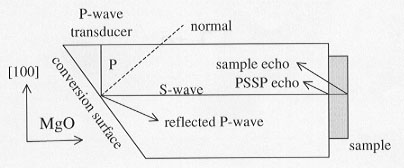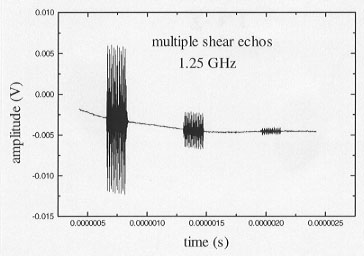

The development of Ultrasonic Interferometry at GHz frequencies facilitates the measurement of elastic wave speeds on sub-millimeter-sized single crystals. However, this relatively new tool has been largely limited to compressional waves because ultra-short wavelength (˜1 µm) shear waves are difficult to produce with traditional ultrasonic transducers. Modification of a piezoelectric ultrasonic transducer has produced high-frequency shear waves, but of low quality and only over a very narrow frequency band. Here, we describe the generation of MHz-GHz shear waves by conversion from P- to S-waves.
Seismologists have long known about the conversion of elastic wave particle motion in solids between compressional (P) and transverse (S) forms upon reflection described by the acoustic analogy of Snell's law. We borrowed this idea to generate GHz frequency shear waves by the P to S conversion on the internal facet of an oriented MgO prism. The input P-wave is generated by a sputtered three layer (Au-ZnO-Au) coating. The incident P-wave strikes the internal surface of the MgO prism at an angle of incidence such that the incident P-wave is orthogonal to the reflected S-wave (Fig. 3.7-1). This allows us to take advantage of the
 |
Fig. 3.7-1: Illustration of the MgO shear wave generator. |
orthogonal pure mode directions in cubic MgO, as well as allowing the symmetric return of the wave (PSSP) for detection at the source transducer. For MgO, the angle of incidence is about 54°. A set of three PSSP echos from one input pulse are illustrated in Figure 3.7-2.
 |
Fig. 3.7-2: Illustration of PSSP echos generated in the MgO prism at 1.25 GHz. |
Interferometry can be performed by gluing a sample to the prism face, which back-reflects the S-wave. The generator is operable from 600 MHz to 2.1 GHz and limited at high-frequency only by the upper limit of the RF generator. We used this new GHz shear wave generator to measure the S-wave travel time through a 180 µm thick [100]-oriented single crystal of periclase and find that Vs[100] = 6619(40) m/s corresponding to c44 = 157(2) GPa. In this experiment, accuracy of the travel time determination from 1.0 to 2.0 GHz is about 4 parts in 104.

Tel: +49-(0) 921 55 3700 / 3766, Fax: +49-(0) 921 55 3769, E-mail: bayerisches.geoinstitut(at)uni-bayreuth.de
 Previous page
Previous page